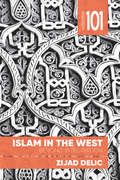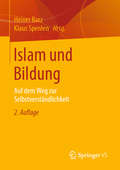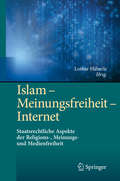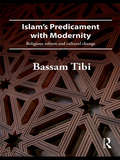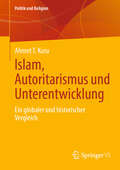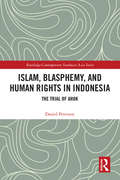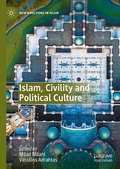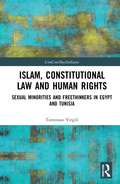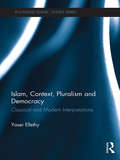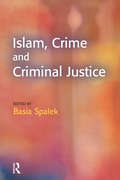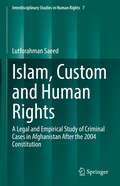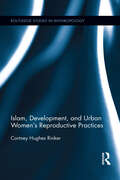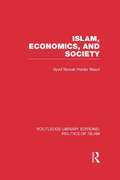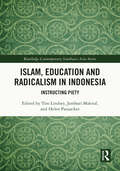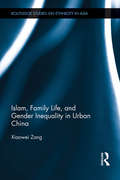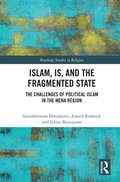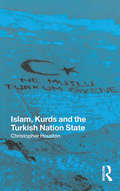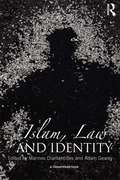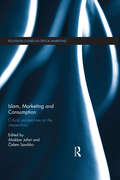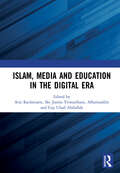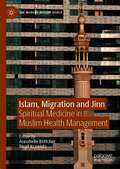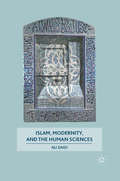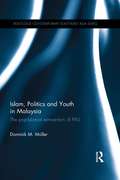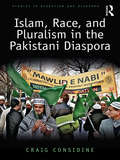- Table View
- List View
Islam in the West: Beyond Integration (Collection 101)
by Imam Zijad DelicIslam in the West: Beyond Integration offers an overview and a profile of Muslims living in the West, their identity, integration and citizenship. The book tries to answer some hard questions surrounding the interplay between religious and national identities, and how these two types of identities negotiate their place in the hearts of Western Muslims. Case studies cover constructive integration in Canada, assimilation in France and the exclusionist approach in Bosnia. Some answers to the questions on citizenship are presented from an Islamic perspective, taking into account Islamic formative principles — the Qur’an and Sunnah (the Prophetic tradition) — as they pertain to the globalized world of today. This includes an examination of historical perspectives found in the scholarly discourses on citizenship unearthed from early Muslim history as well as from contemporary times. These issues are analyzed through the prism of a religiously pluralistic and culturally diverse society. This book is published in English. - Le besoin de mieux comprendre l’identité, l’intégration, la citoyenneté, l’appartenance et la loyauté musulmanes en Occident n’a jamais été aussi grand. Ce petit livre aborde les grandes problématiques portant sur les musulmans canadiens. Qui sont les musulmans canadiens ? Que faut-il pour qu’un pays soit une terre d’accueil saine et accueillante ? Ces questions sont abordées dans la première section. Qu’est-ce que l’identité musulmane canadienne ? Cette section offre des pistes de réponses aux difficiles questions entourant l’interaction entre les identités religieuse et nationale. Sont-elles contradictoires ou complémentaires ? Comment se compare le modèle canadien d’intégration ? Deux modèles très différents sont présentés à titre de comparaisons : le modèle d’assimilation à la française, et l’approche bosnienne d’exclusion. Qu’est-ce que la « citoyenneté » d’un point de vue islamique ? La dernière section explore les principes formateurs de l’Islam – le Coran et la sunna (tradition prophétique) à l’ère de la mondialisation. L’histoire de l’Islam, y compris son histoire contemporaine jettent un éclairage intéressant sur la question. Fondé sur la compréhension accrue et le respect, ce petit livre contribue de manière positive au débat actuel sur la place des musulmans canadiens et de l’Islam au Canada. Voici le titre inaugural de la Collection 101, une série de brèves introductions, en 101 pages, aux grands débats de société. Ce livre est publié en anglais.
Islam und Bildung: Auf dem Weg zur Selbstverständlichkeit
by Heiner Barz Klaus SpenlenAusgewiesene Expertinnen und Experten analysieren die vielfältigen Erscheinungsformen muslimischen Glaubens in Deutschland. Neben Dschihadismus und Salafismus widmet sich der Band vor allem auch der schweigenden Mehrheit der Muslime, die ihren Glauben als Bestandteil ihrer Kultur friedlich leben will. Deutlich wird, dass im gelebten Islam heute auch produktive Traditionen mit Betonung auf Bildung und Wissenschaft wirksam werden.
Islam – Meinungsfreiheit – Internet: Staatsrechtliche Aspekte der Religions-, Meinungs- und Medienfreiheit
by Lothar HäberleDas Themenspektrum dieses Buches erscheint weit gespannt. Meinungsfreiheit bildet das Scharnier zwischen Islam und Internet, hat mit beiden gemeinsame Konfliktfelder. In diesem Spannungsfeld erläutern Staatsrechtslehrer wie Udo Steiner, Michael Sachs und Klaus F. Gärditz Aspekte der Meinungsfreiheit wie auch der Religions-, Kunst- und Pressefreiheit. Aber gibt es auch Schnittmengen zwischen Islam und Internet? Die geistige, publizistische und politische Auseinandersetzung um den Islam in Deutschland und Europa findet zu guten Teilen im Internet statt. Dabei wirkt das Internet als Konfliktverstärker: Dessen anonyme Nutzung bewirkt mangelnde Zurechenbarkeit und Verantwortlichkeit für Duktus und Inhalt des eigenen Beitrags. Unsichtbar bleibt auch der Kritisierte. So wirkt das Internet enthemmend. Wie Islamgegner oder -feinde das Internet nutzen, so gleichermaßen Islamisten: zu Propaganda, zur Anwerbung von IS-Sympathisanten oder -Kämpfern, zur Vorbereitung von Anschlägen und anderen Straftaten. Spannen beide Seiten das Internet für ihre gegenläufigen Zwecke ein, verstärken sich die Konflikte erheblich. Das Internet-Phänomen „Echokammer“ (Abkapselung Gleichgesinnter) trägt erheblich bei zu wachsender Sprachlosigkeit zwischen verschiedenen gesellschaftlichen Gruppen. Hate Speech, massive Beleidigungen, Drohungen verschärfen die Gegnerschaft. Zentrifugale Kräfte der Gesellschaft werden verstärkt, nicht nur sichtbarer. In mehreren Beiträgen wird hierbei die Rolle des Internets untersucht, werden Ansatzpunkte möglicher Regulierungen sowie problemgerechte Lösungen aufgezeigt.
Islam's Predicament with Modernity: Religious Reform and Cultural Change
by Bassam TibiIslam's Predicament with Modernity presents an in-depth cultural and political analysis of the issue of political Islam as a potential source of tensions and conflict, and how this might be peacefully resolved. Looking at the issue of modernity from an Islamic point of view, the author examines the role of culture and religion in Muslim society under conditions of globalisation, and analyses issues such as law, knowledge and human rights. He engages a number of significant studies on political Islam and draws on detailed case studies, rejecting the approaches of both Orientalists and apologists and calling instead for a genuine Islamic pluralism that accepts the equality of others. Situating modernity as a Western product at the crux of his argument, he argues that a separation of religion and politics is required, which presents a challenge to the Islamic worldview. This critical analysis of value conflicts, tensions and change in the Islamic world will be of interest to scholars and advanced students of international relations, social theory, political science, religion, Islamic studies and Middle Eastern studies.
Islam, Autoritarismus und Unterentwicklung: Ein globaler und historischer Vergleich (Politik und Religion)
by Ahmet T. KuruWarum weisen Länder mit muslimischer Bevölkerungsmehrheit im Vergleich zum Weltdurchschnitt ein niedriges Maß an Demokratie und sozioökonomischer Entwicklung auf? Dieses Buch kritisiert Erklärungen, die den Islam als Ursache dieser Ungleichheit anführen, da die Muslime zwischen dem 9. und 12. Jahrhundert philosophisch und sozioökonomisch weiter fortgeschritten waren als die Westeuropäer. Auch der westliche Kolonialismus war nicht die Ursache: Die Muslime litten bereits unter politischen und sozioökonomischen Problemen, als die Kolonisierung begann. Dieses Buch argumentiert, dass die Muslime in ihrer frühen Geschichte, als in Europa religiöse Orthodoxie und Militärherrschaft vorherrschten, einflussreiche Denker und Kaufleute hatten. Im 11. Jahrhundert entstand jedoch ein Bündnis zwischen orthodoxen islamischen Gelehrten (den Ulema) und Militärstaaten. Dieses Bündnis erstickte allmählich die intellektuelle und wirtschaftliche Kreativität, indem es die intellektuellen und bürgerlichen Klassen in der muslimischen Welt marginalisierte. Dieses Bündnis behindert auch heute noch Kreativität und Wettbewerb in muslimischen Ländern. Die Rohfassung der deutschen Übersetzung hat ein maschinelles Übersetzungsprogramm mit Hilfe künstlicher Intelligenz angefertigt. Eine anschließende menschliche Überarbeitung erfolgte vor allem in inhaltlicher Hinsicht, so dass sich das Buch stilistisch anders lesen wird als eine herkömmliche Übersetzung.
Islam, Blasphemy, and Human Rights in Indonesia: The Trial of Ahok (Routledge Contemporary Southeast Asia Series)
by Daniel PetersonUsing the high-profile 2017 blasphemy trial of the former governor of Jakarta, Basuki ‘Ahok’ Tjahaja Purnama, as its sole case study, this book assesses whether Indonesia’s liberal democratic human rights legal regime can withstand the rise of growing Islamist majoritarian sentiment. Specifically, this book analyses whether a 2010 decision of Indonesia’s Constitutional Court has rendered the liberal democratic human rights guarantees contained in Indonesia’s 1945 Constitution ineffective. Key legal documents, including the indictment issued by the North Jakarta Attorney-General and General Prosecutor, the defence’s ‘Notice of Defence’, and the North Jakarta State Court’s convicting judgment, are examined. The book shows how Islamist majoritarians in Indonesia have hijacked human rights discourse by attributing new, inaccurate meanings to key liberal democratic concepts. This has provided them with a human rights law-based justification for the prioritisation of the religious sensibilities and religious orthodoxy of Indonesia’s Muslim majority over the fundamental rights of the country’s religious minorities. While Ahok’s conviction evidences this, the book cautions that matters pertaining to public religion will remain a site of contestation in contemporary Indonesia for the foreseeable future. A groundbreaking study of the Ahok trial, the blasphemy law, and the contentious politics of religious freedom and cultural citizenship in Indonesia, this book will be of interest to academics working in the fields of religion, Islamic studies, religious studies, law and society, law and development, law reform, constitutionalism, politics, history and social change, and Southeast Asian studies.
Islam, Civility and Political Culture (New Directions in Islam)
by Milad Milani Vassilios AdrahtasThis book provides a comprehensive and interdisciplinary exploration of civility and political culture in the Muslim world.The contributions consider the changing interface between religion and politics throughout Islamic history, and into the present. Extending beyond saturated approaches of ‘political’ and/or ‘militant’ Islam, this collection captures the complex sociopolitical character of Islam, and identifies tensions between the political-secular and the sacred-religious in contemporary Muslim life. The alternative conceptual framework to traditional analyses of secularisation and civility presented across this volume will be of interest to students and scholars across Islamic studies, religious studies, sociology and political science, civilisation studies, and cultural studies.
Islam, Constitutional Law and Human Rights: Sexual Minorities And Freethinkers In Egypt And Tunisia (Comparative Constitutionalism in Muslim Majority States)
by Tommaso VirgiliThis book focuses on Islamic constitutionalism, and in particular on the relation between religion and the protection of individual liberties potentially clashing with shariᶜa and the Islamic ethos. The analysis goes from general to particular, starting with a theoretical overview on constitutionalism, human rights and Islam, moving to the assessment of the post-Arab Spring Constitutions of Egypt and Tunisia, and concluding with a specific focus on the rights of sexual minorities and freethinkers. Part I provides a theoretical account of the conception of constitutionalism and human rights in Islam, compared and contrasted with Western constitutionalism. A set of issues where the tension between shariᶜa and human rights is accentuated is analysed against the backdrop of the main Islamic charters of rights. Part II conducts a similar assessment based on the Constitutions of Tunisia and Egypt – the two main epicentres of the Arab Spring. Part III moves to two specific rights in the same countries, from the twofold perspective of the Constitutions and international law: the freedom from interference in one’s intimate life, with particular regard to homosexuality; and the freedom of holding and expressing nonconventional beliefs, deemed unacceptable from the point of view of traditional Islam. These issues have been chosen as representative of the most controversial, still considered taboo in both legal and social terms, hence at the fringes of the debate on individual freedoms. Focusing on two overlooked and underexplored issues, the work thus pushes the boundaries of the human rights discourse in Muslim contexts.
Islam, Context, Pluralism and Democracy: Classical and Modern Interpretations (Routledge Islamic Studies Series)
by Yaser EllethyIslam, Context, Pluralism and Democracy aspires to clarify the tensions and congruences between the revelational and the rational, the text and the context, the limits and the horizons of contextualization in Islam, as these emanate from the Islamic interpretative tradition. This book examines classical and modern Muslim interpretations with regard to the concepts of diachronic development, pluralism and democracy based on Arabic-Islamic sources and literature. Focusing on the parameters of semantic changes, methods of interpretation and cultural variables, it shows how this interpretative tradition offers a diversity of ideas and approaches that can be utilized in contemporary debates concerning the socio-political contextualization of Islamic genuine thought. However, within this diversity, Islam presents generic principles and core values as 'moral paradigms' that can deal with such modern challenges. Based on the analysis of core Islamic texts and key-terms related to the discussed issues, mainly from the Quran and the Sunnah, and the broader Arabic-Islamic literature, it explores the boundaries of the mutable and constant in the Islamic worldview. Presenting classical Muslim interpretations and scholars as possible interlocutors in debates over the compatibility of Islam with challenges of modernity, this book is essential reading for researchers and postgraduates interested in Islamic Studies, Philosophy of Religion and Political Science.
Islam, Crime and Criminal Justice
by Basia SpalekThis book brings together research into key aspects of the interconnections between Islam, crime and the criminal justice system in Britain, a particularly timely collection in the light of both the recent disturbances in several northern English cities as well as the impact of the events of 11 September 2001 and their aftermath. Chapters in the book focus on young Muslim men and criminal activity, Muslim women and their experiences of victimisation, the experiences of Muslim police officers, of Muslims in prison, issues of human rights in relation to Muslims in Britain, and the criminal justice policy implications of religious diversity. Main aims pursued through the book include issues of victimisation as perceived by Muslim communities, Muslim perspectives on crime and criminal justice, and ways of addressing issues of marginalisation and exclusion within Muslim communities. Overall the book provides an important contribution to debates over the role of Muslims in British society generally, as well as their experiences of and involvement in the criminal justice system and the policy implications that arise from this.
Islam, Custom and Human Rights: A Legal and Empirical Study of Criminal Cases in Afghanistan After the 2004 Constitution (Interdisciplinary Studies in Human Rights #7)
by Lutforahman SaeedFor the first time, the author has explored the intertwinement of written law, Islamic law, and customary law in the highly complex Afghan society, being deeply influenced by traditional cultural and religious convictions. Given these facts, the author explores how to bridge the exigencies of a human rights–driven penal law and conflicting social norms and understandings by using the rich tradition of Islamic law and its possible openness for contemporary rule of law standards. This work is based on ample field research in connection with a thorough analysis of the normative contexts. It is a landmark, since it offers broadly acceptable and thus feasible solutions for the Afghan legal practice. The book is of equal interest for scientists and practitioners interested in legal, religious, social, and political developments concerning human rights and regional traditions in the MENA region, in Afghanistan in particular.
Islam, Development, and Urban Women's Reproductive Practices (Routledge Studies in Anthropology #9)
by Cortney Hughes RinkerDrawing on fieldwork conducted in Rabat, Morocco, this ethnography analyzes the relationship between neoliberal development policies, women’s reproductive practices, and popular understandings of Islam. In the 1990s, Morocco shifted its attention from economic to human development, as economic reforms in the preceding decades ultimately did not address social issues such as access to healthcare and education and poverty. Development programs like the National Initiative for Human Development seek to create modern citizens who are responsible, self-sustaining, and will make choices that better their well being. Hughes Rinker considers the implications that the reorientation from primarily economic to social development has on reproductive healthcare. Drawing on observations in health clinics; interviews with patients, medical staff, and at government and development agencies; and a document analysis, she demonstrates how women appropriate the medical practices and spaces of intervention aimed at creating modern citizens to form new religious identities, novel ideas of motherhood, and interpretations of neoliberal citizenship based on Islamic beliefs. Women’s interpretations of Islam are not incompatible with the state’s agenda for modernization, but rather serve as rationale for women to accept modern reproductive practices, such as contraception and pregnancy tests. However, even though female patients appropriate medical practices, they reinscribe development tropes that suggest they participate in modernization through their reproductive bodies and mothering instead of their productive labor. Hughes Rinker complicates neoliberalism as she shows it is unproductive to have a set conceptualization of neoliberal citizens, and more productive to examine the practices and discourses that create such citizens.
Islam, Economics, and Society: Politics Of Islam: Islam, Economics, And Society (Routledge Library Editions: Politics of Islam)
by Syed Nawab Haider NaqviThe Islamic perception of the socio-economic process is dynamic and its insistence on social justice is uncompromising. To produce the best social structure, according to this view, man’s economic endeavours should be motivated by a meaningful moral philosophy. In the face of the challenges presented by the modern world, the practice of Islamic economics raises many complex and profound issues. These are addressed in this highly important work, which must be considered essential reading for all those who live in the vision of the ‘right’. First published in 1994.
Islam, Education and Radicalism in Indonesia: Instructing Piety (Routledge Contemporary Southeast Asia Series)
by Tim Lindsey Helen Pausacker Jamhari MakrufThis book explores the connections between traditional Islamic education, rising religious intolerance, religious attitudes to gender, campaigns for curricula innovation and modernisation, and politics and society in Indonesia. Drawing on extensive original research and the deep experience of the authors, the book highlights tensions between traditional Islamic educators and modernisers, and between different understandings of Islam, emphasising the importance of these issues for the future of Indonesia.
Islam, Family Life, and Gender Inequality in Urban China (Routledge Studies on Ethnicity in Asia)
by Xiaowei ZangThis book studies the relationship between Islam, family processes, and gender inequality among Uyghur Muslims in Ürümchi, China. Empirically, it shows in quantitative terms the extent of gender inequalities among Uyghur Muslims in Ürümchi and tests whether the gender inequalities are a difference in kind or in degree. It examines five aspects of gender inequality: employment, income, household task accomplishment, home management, and spousal power. Theoretically, it investigates how Islamic affiliation and family life affect Uyghur women’s status. Zang’s research involved rare and privileged access to a setting which is difficult for foreign scholars to study due to political restrictions. The data are drawn from fieldwork in Ürümchi between 2005 and 2008, which include a survey of 577 families, field observations, and 200 in-depth interviews with local Uyghurs. The book combines qualitative and quantitative data and methods to study gendered behavior and outcomes. The author’s study reinterprets family power and offers a more nuanced analysis of gender and domestic power in China and makes a pioneering effort to study spousal power, gender inequality in labor market outcomes, and gender inequality in household chores among members of ethnic minorities in China. The book will be of interest to students and scholars of ethnic studies, Chinese studies, Asian anthropology and cultural sociology.
Islam, IS and the Fragmented State: The Challenges of Political Islam in the MENA Region (Routledge Studies in Religion)
by Juline Beaujouan Amjed Rasheed Anoush EhteshamiThis book provides a pioneering and original study of the regional effects of political Islam. It sets out the multifaceted interactions between Islam and politics in the Middle East and North Africa (MENA) region, focussing in particular on the so-called Islamic State (IS) organization in its broad discussion of political Islam. Utilizing a trans-disciplinary perspective, the book interacts with social constructivism and complex realism theories to analyse the clash between the modern notion of the state and that of identity in the region. Looking at issues such as the rise of IS and its attempts to establish a caliphate, the book offers three different, yet complementary, levels of analysis for its discussion. These being: Regional (dis)order, the erosion of state power and its boundaries, and the role of non-state actors in shaping the politics of the MENA region. Each of these levels are addressed in detail in turn in order to build a comprehensive picture of state and political Islam in the Arab core of the MENA region. What emerges is a comprehensive analysis of the interlinked relationships between political and Islamic elements of Arab polities and societies. As such, this book will be of great interest to academics and policymakers focusing on matters relating to the study of Islam, Islam and politics, study of religion more broadly, and security studies and area studies, particularly in the MENA region.
Islam, Kurds and the Turkish Nation State
by Christopher HoustonCan Islamism, as is often claimed, truly unite Muslim Turks and Kurds in a discourse that supersedes ethnicity? This is a volatile and exciting time for a country whose long history has been characterized by dramatic power play. Evolving out of two years of fieldwork in Istanbul, this book examines the fragmenting Islamist political movement in Turkey. As Turkey emerges from a repressive modernizing project, various political identities are emerging and competing for influence. The Islamist movement celebrates the failure of Western liberalism in Turkey and the return of politics based on Muslim ideals. However, this vision is threatened by Kurdish nationalism and the country's troubled past. Is Islamist multiculturalism even possible? The ethnic tensions surfacing in Turkey beg the question whether the Muslim Turks and Kurds can find common ground in religion. Houston argues that such unification depends fundamentally upon the flexibility of the rationale behind the Islamist movement's struggle.
Islam, Law and Identity
by Adam Gearey Marinos DiamantidesThe essays brought together in Islam, Law and Identity are the product of a series of interdisciplinary workshops that brought together scholars from a plethora of countries. Funded by the British Academy the workshops convened over a period of two years in London, Cairo and Izmir. The workshops and the ensuing papers focus on recent debates about the nature of sacred and secular law and most engage case studies from specific countries including Egypt, Israel, Kazakhstan, Mauritania, Pakistan and the UK. Islam, Law and Identity also addresses broader and over-arching concerns about relationships between religion, human rights, law and modernity. Drawing on a variety of theoretical and empirical approaches, the collection presents law as central to the complex ways in which different Muslim communities and institutions create and re-create their identities around inherently ambiguous symbols of faith. From their different perspectives, the essays argue that there is no essential conflict between secular law and Shari`a but various different articulations of the sacred and the secular. Islam, Law and Identity explores a more nuanced and sophisticated understanding of the tensions that animate such terms as Shari`a law, modernity and secularization
Islam, Marketing and Consumption: Critical Perspectives on the Intersections (Routledge Studies in Critical Marketing)
by Aliakbar Jafari Özlem SandikciIn recent years, a critically oriented sub-stream of research on Muslim consumers and businesses has begun to emerge. This scholarship, located both within and outside the marketing field, adopts a socio-culturally situated approach to Islam and investigates the complex and multifaceted intersections between Islam and markets. This book seeks to reflect various unheard and emerging critical voices from within the Muslim world, and provide a series of critical insights on how, if and why Islam matters to marketing theory and practice. It questions the existing assumptions and polarising discussions which underpin the portrayal of Islam as the ‘other’ of Modernity, while acknowledging that Muslims themselves are partially responsible for creating stereotyped representations of Islam and ‘the Muslim’. This wide-ranging and insightful collection will advance emerging critical perspectives, and provide new insights that will influence the generation and application of knowledge in the context of Muslim societies. It will open up fresh conversations for scholars in marketing as well as the broader humanities and social sciences.
Islam, Media and Education in the Digital Era: Proceedings of the 3rd Social and Humanities Research Symposium (SoRes 2020), 23 – 24 November 2020, Bandung, Indonesia
by Atie RachmiatieThe proceedings of the Social and Humanities Research Symposium (SoRes) shares ideas, either research results or literature review, on islam, media and education in the digital era. Some recent issues consists of innovative education in the digital era, new media and journalsm, islamic education, human wellbeing, marketing and fintech in terms of islamic perspective, economic welfare, law and ethics. It is expected that the proceedings will give new insights to the knowledge and practice of social and humanities research. Therefore, such parties involved in social and humanities research as academics, practitioners, business leaders, and others will acquire benefits from the contents of the proceedings.
Islam, Migration and Jinn: Spiritual Medicine in Muslim Health Management (The Modern Muslim World)
by Birgit Krawietz Annabelle BöttcherThis book explores the agency of Jinn, the so-called “demons of Islam”. They are regarded as mostly invisible and highly mobile creatures. In a globalized world with manifold forms of forced and voluntary migrations, Jinn are likewise on the move, interfering in the human world and affecting the mental and physical health of Muslims. This continuous challenge has so far been mainly addressed by traditional Muslim health management and by the so-called spiritual medicine or medicine of the Prophet. This book shifts perspective. Its interdisciplinary chapters deal with the transformation of manifold cultural resources by first analyzing the doctrinal and cultural history of Jinn and the treatment of Jinn affliction in Arabic texts and other sources. It then discusses case studies of Muslims and current health management approaches in the Middle East, namely in Egypt and Syria. Finally, it turns to the role of Jinn in a number of migratory settings such as Spain, Denmark, Great Britain and Guantanamo.
Islam, Modernity, and the Human Sciences
by Ali ZaidiAli Zaidi discloses a largely unnoticed dialogue between Muslim and Western social thought on the search for meaning and transcendence in the human sciences. This disclosure is accomplished by a comparative reading of Muslim debates on secular knowledge on the one hand and of Western debates on the putative death of metaphysics in the human sciences on the other hand. The analysis is grounded in dialogical hermeneutics; that is, a hermeneutic approach to texts and cultural traditions that draws upon the work of Hans-Georg Gadamer and upon the insights of inter-religious dialogue.
Islam, Nationalism and Communism in a Traditional Society: The Case of Sudan
by Gabriel WarburgFirst Published in 1978. Routledge is an imprint of Taylor & Francis, an informa company.
Islam, Politics and Youth in Malaysia: The Pop-Islamist Reinvention of PAS (Routledge Contemporary Southeast Asia Series)
by Dominik M. MuellerProviding an ethnographic account of the Islamic Party of Malaysia (PAS) and its Youth Wing (Dewan Pemuda PAS), this book analyses the genesis and role of Islamic movements in terms of their engagement in mainstream politics. It explores the party’s changing approach towards popular culture and critically investigates whether the narrative of a post-Islamist turn can be applied to the PAS Youth. The book shows that in contrast to the assumption that Islamic marketization and post-Islamism are reinforcing each other, the PAS Youth has strategically appropriated and integrated Islamic consumerism to pursue a decidedly Islamist – or ‘pop-Islamist’ – political agenda. The media-savvy PAS Youth elites, which are at the forefront of implementing new outreach strategies for the party, categorically oppose tendencies of political moderation among the senior party. Instead, they are most passionately calling for the establishment of a Syariah-based Islamic oder for state and society, although these renewed calls are increasingly expressed through modern channels such as Facebook, YouTube, rock music, celebrity advertising, branded commodities and other market-driven forms of social movement mobilization. A timely and significant contribution to the literature on Islam and politics in Malaysia and beyond, this book sheds new light on widespread assumptions or even hopes of "post-Islamism". It is of interest to students and scholars of Political Religion and Southeast Asian Politics.
Islam, Race, and Pluralism in the Pakistani Diaspora (Studies in Migration and Diaspora)
by Craig ConsidineThis book explores the Pakistani diaspora in a transatlantic context, enquiring into the ways in which young first- and second-generation Pakistani Muslim and non-Muslim men resist hegemonic identity narratives and respond to their marginalised conditions. Drawing on rich documentary, ethnographic and interview material gathered in Boston and Dublin, Islam, Race, and Pluralism in the Pakistani Diaspora introduces the term ‘Pakphobia’, a dividing line that is set up to define the places that are safe and to distinguish ‘us’ and ‘them’ in a Pakistani diasporic context. With a multiple case study design, which accounts for the heterogeneity of Pakistani populations, the author explores the language of fear and how this fear has given rise to a ‘politics of fear’ whose aim is to distract and divide communities. A rich, cross-national study of one of the largest minority groups in the US and Western Europe, this book will appeal to sociologists, anthropologists, political scientists, and geographers with interests in race and ethnicity, migration and diasporic communities.
